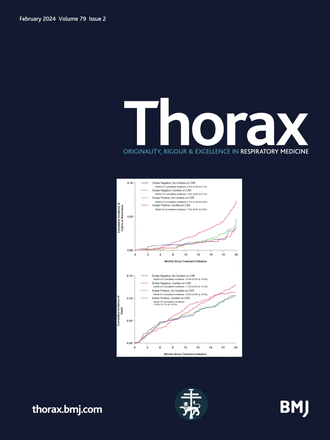吸入皮质类固醇给药时机对哮喘的影响:一项随机三方向交叉试验
IF 9
1区 医学
Q1 RESPIRATORY SYSTEM
引用次数: 0
摘要
哮喘表现出强烈的日常节律,气流阻塞和气道炎症在夜间达到高峰。调整药物给药时间与疾病的节律(时间疗法)可以提高治疗效果。我们的目的是评估吸入皮质类固醇给药时机对哮喘的影响。方法采用三组随机交叉试验。轻度至中度特应性哮喘患者随机接受二丙酸倍氯米松治疗:(1)400µg,每日一次,08:00 - 09:00 (ODAM);(2)每日15:00 - 16:00 (ODPM) 400µg一次;(3)在08:00 - 09:00和20:00 - 21:00 (BD)之间每天两次200µg,连续28天,两次治疗之间有2周的洗脱期。在磨合期后的24小时内和每个治疗期结束时测量6小时肺活量和生物标志物。结果25名参与者中,21名完成了所有方案。ODPM改善22:00 FEV1(中位(IQR): +160 (+70, +270) ml)优于ODAM (- 20 (- 80, +230) ml)和BD (+80 (- 20, +200) ml)。与BD和ODAM相比,ODPM在夜间(22:00和04:00)对血液嗜酸性粒细胞计数的抑制效果更好。所有的治疗方案都改善了哮喘控制,降低了呼出一氧化氮和血清皮质醇水平,不同的给药方案之间没有差异。结论与BD和ODAM相比,ODPM能更好地抑制夜间肺功能下降和血嗜酸性粒细胞计数峰值;这并没有增加不良事件。未来的试验有必要在现实生活中验证这些发现,并确定哪些人群可能从时间疗法中获益最多。如有合理要求,可提供资料。研究方案可在试验注册网站上查阅。在去识别后,作为本文报告结果基础的个体参与者数据将在文章发表3年后与研究发起人批准数据使用的研究者共享。建议将发送至pmoore@crosolutions.co.uk。为了获得访问权限,数据请求者需要签署数据访问协议。本文章由计算机程序翻译,如有差异,请以英文原文为准。
The impact of dosage timing for inhaled corticosteroids in asthma: a randomised three-way crossover trial
Background Asthma demonstrates a robust daily rhythm, with airflow obstruction and airway inflammation peaking overnight. Aligning the timing of drug administration with rhythms in disease (chronotherapy) may improve therapeutic efficacy. We aimed to evaluate the impact of dosage timing for inhaled corticosteroids in asthma. Methods This is a randomised three-way crossover trial. Participants with mild to moderate atopic asthma were randomised to beclometasone dipropionate: (1) 400 µg once daily between 08:00 and 09:00 (ODAM); (2) 400 µg once daily between 15:00 and 16:00 (ODPM); and (3) 200 µg twice daily between 08:00 and 09:00 and between 20:00 and 21:00 (BD) for 28 days, with a 2 week washout period in between treatment periods. Six-hourly spirometry and biomarkers were measured over 24 hours following the run-in period and at the end of each treatment period. Results Of 25 participants, 21 completed all regimens. ODPM was superior in improving 22:00 FEV1 (median (IQR): +160 (+70, +270) ml) compared with ODAM (−20 (−80, +230) ml) and BD (+80 (−20, +200) ml). ODPM resulted in better overnight (22:00 and 04:00) suppression in blood eosinophil counts compared with BD and ODAM. All regimens improved asthma control and reduced fractional exhaled nitric oxide and serum cortisol levels with no difference among dosing regimens. Conclusion ODPM better suppresses the nocturnal dip in lung function and peak of blood eosinophil counts compared with BD and ODAM; this was without an increase in adverse events. Future trials are warranted to validate these findings in real-life settings and to determine which population may best benefit from chronotherapy. Data are available upon reasonable request. The study protocol is available on trial registration website. Individual participant data that underlie the results reported in this article after deidentification will be shared 3 years following article publication with investigators whose proposed use of data has been approved by the study sponsor. Proposal will be directed to pmoore@crosolutions.co.uk. To gain access, data requestors will need to sign a data access agreement.
求助全文
通过发布文献求助,成功后即可免费获取论文全文。
去求助
来源期刊

Thorax
医学-呼吸系统
CiteScore
16.10
自引率
2.00%
发文量
197
审稿时长
1 months
期刊介绍:
Thorax stands as one of the premier respiratory medicine journals globally, featuring clinical and experimental research articles spanning respiratory medicine, pediatrics, immunology, pharmacology, pathology, and surgery. The journal's mission is to publish noteworthy advancements in scientific understanding that are poised to influence clinical practice significantly. This encompasses articles delving into basic and translational mechanisms applicable to clinical material, covering areas such as cell and molecular biology, genetics, epidemiology, and immunology.
 求助内容:
求助内容: 应助结果提醒方式:
应助结果提醒方式:


